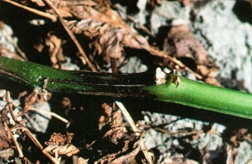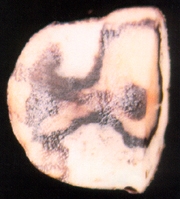Bulletin #2493, Potato Facts: Blackleg and Bacterial Soft Rot
By Steven B. Johnson, Ph.D., Extension Crops Specialist
For information about UMaine Extension programs and resources, visit extension.umaine.edu.
Find more of our publications and books at extension.umaine.edu/publications/.
Blackleg and bacterial soft rot are diseases that are caused by different, but closely related bacteria. These pathogens are found worldwide, as are the diseases.
These bacteria reside in the lenticels of the potato tubers. They only require proper environmental conditions to cause disease. Warm, moist conditions favor disease development in the field. In storage, a film of water will induce anaerobic conditions of the tuber, which encourages soft rot.
Once proper environmental conditions occur, disease can result. Decay can actually occur between the temperatures of 45 and 90 degrees F, but rot increases dramatically when temperatures are over 70 degrees F.
These bacteria are spread in and on potato seed pieces, in old potato stems and stalks, water, soil on potatoes, insects and any mechanical methods, such as soil movement or human activity. The pathogens can cause losses in the field as well as losses in potato storages.
Blackleg

Blackleg is caused by the bacterium Pectobacterium atrosepticum (Synonym: Erwinia carotovora subsp. atroseptica). The name of the disease comes from the black lesions produced on infected stems. The disease affects stems and tubers. Stems of infected plants typically have inky black symptoms, which usually begin at the decaying seed piece and may extend up the entire length of the stem. Stem pith can be decayed above the black discoloration, and vascular tissues can be discolored. Leaves turn yellow and leaflets tend to roll upwards at the margins. Leaflets, and later entire plants, may wilt and eventually decline. In wet weather, decay is wet and slimy and may spread to most of the plant. Under dry conditions, infected tissue becomes dry and shriveled, and the disease is often restricted to the underground portions of the stem. Blackleg that occurs early in the growing season results in weak, upright, yellowed plants that usually succumb to decay.
Disease is favored by moist conditions with temperatures less than 65 degrees F. It can be spread rapidly by wind-blown rain. Cool, wet soils at planting followed by high temperatures after plants emerge favor postemergence blackleg. Higher soil temperatures at planting favor seed piece decay and preemergence death of shoots. Invasion of seed pieces by Fusarium spp. tends to predispose the tissues to wet breakdown and favor blackleg development. Reduced stands can result from blackleg-infected seed lots. Affected stems may or may not turn yellow, but eventually, they wilt and decay.
Tubers of infected plants may show symptoms ranging from slight vascular discoloration at the stolon end to wet breakdown of the entire pith, extending inwards from the stem end. The bacterium can enter tubers through stolons and produce various symptoms on the tubers. The most pronounced symptoms appear near midseason. Inky-black, slightly sunken lesions develop at the stem end of the tuber. The flesh of the tubers is cream colored, gradually turning to grayish and finally black. Irregular cavities with blackened walls may extend through the center of the potato tuber. The blackleg organism may also infect lenticels, causing them to be slightly sunken and brownish to black in color. The infected lenticles can be up to 1/4 inch in diameter. The tissues under the infected lenticels are brownish and usually dry. This extends less than 1/8 inch into the tuber flesh. New tubers from infected plants may become soft and slightly discolored in the vascular tissue at the stem end. In advanced stages, the center of the tuber will be decayed, leaving only an outer shell. Spread in storage is minimal.
Disease severity is greatly influenced by the degree of seed lot contamination, seed-handling techniques, soil moisture and temperature at planting, environmental conditions during the growing season and exposure to external sources of the bacterium, such as irrigation. Most of the serious blackleg outbreaks are from seed-borne blackleg. The pathogen is spread from seed piece to seed piece by physical handling and by machinery, such as cutting knives and planting equipment. Insects can spread the bacterium in a field by feeding on an infected potato stem. Feeding wounds provide a site for the bacterium to invade.
Blackleg Control
Blackleg control centers on minimizing the amount of bacterial contamination in seed lots. If growers start with seed free from blackleg contamination, the disease can be kept at very low levels in a limited generation system. Seed pieces can be infected without showing any symptoms. The bacterium that causes blackleg does not survive well outside of the potato. A good rotation program (avoid planting potatoes after potatoes) will help control this disease.
Seed cutting can spread the bacterium from a low level in the seed lot to a high level very quickly. Sanitation and disinfecting of potato cutting equipment and proper handling reduces spread and aids in the control of the pathogen. Treating seed to prevent seed piece decay by fungi can also contribute to blackleg control. Since the pathogen does well in cool, wet soils, avoid planting in overly wet soil.
Providing good air circulation when storing the tubers, particularly as they enter the storage to promote drying, aids in the control of blackleg. Growers do not have to live with blackleg. Much of the problem can be eliminated with sanitation.
Softrot
Potato soft rot is caused by the bacterium Pectobacterium carotovorum (synonym: Erwinia carotovora), a common soil resident. This bacterium can grow between the temperatures of 32 and 90 degrees F, with optimal growth between 70 and 80 degrees F. Bacterial soft rot occurs on a wide range of crops and is one of the most severe postharvest diseases of potatoes worldwide. Loss may occur during storage, transit or marketing. All potatoes varieties are susceptible.
Contamination of potato tubers occurs anytime they come into contact with the bacterium, most commonly during harvest, handling or washing. The bacterium invades the potato tuber chiefly through wounds. Most of the soft rot infections are in tissues that have been weakened, invaded or killed by pathogens or by mechanical means. Soft rot in tubers is favored by immaturity, wounding, invasion by other pathogens, warm tuber and storage temperatures, free water and low oxygen conditions. Tubers harvested at temperatures above 80 degrees F can be predisposed to soft rot. Decay can be retarded by temperatures less that 50 degrees F, the lower the temperature, the better. Immature tubers are susceptible to harvester-related injury and bacterial infection. Suberizing seed and treatment with fungicide is a tactic to reduce the risk of other seed infections that could lead to soft rot breakdown of the seed.

Soft rot on tubers first appears as small, tannish, water-soaked spots on the surface. These spots rapidly enlarge and the tissue decomposes in a soft, blister-like area on the surface of the tuber. Often, a slimy or watery substance oozes from breaks in the blister. The blister margin is darker than the tuber skin. Soft rot often follows bruising and is first white to cream-colored. After exposure to air, it becomes brown to black. The boundary between the disintegrated and the sound tissue is sharp. It is nearly odorless at the stage. As secondary rot occurs, the rot becomes very foul smelling. The rot typically progresses to the point of a chalky-white, foul-smelling mass.
Soft rot bacteria can invade potato lenticels when they are swollen, which is common with exposure to wet soils or soaking in water. The infected areas around the lenticels may be up to 1/4 inch in diameter, slightly raised above and darker in color than the potato skin. Flesh under the infected lenticel appears water soaked and can be a yellow to cream color. The depth of the infection varies from 1/2 to 1/4 inch. When exposed to high temperatures, these infected lenticels may develop into soft rot. Under low temperatures, these lenticel infections can dry out, leaving a shallow spot with a chalky-white deposit under a normal skin color. Fresh, non-suberized wounds can also serve as entry points for the soft rot bacterium.
Soft rot symptoms on the foliage include weak, chlorotic (yellowed) plants with margins of leaflets curled upwards. Stem lesions are usually light brown but can be colorless, but not black. Stems will rot and become very mushy. Tuber rot will occur as point infections often on an eye but can be generalized on the tuber. The tuber rot is colorless and extremely wet and mushy.
Softrot Control
Although symptoms of bacterial soft rot do not begin in the field, control of bacterial soft rot does begin in the field. Other diseases that produce tuber lesions need to be controlled. Consider these suggestions:
- Delaying harvest until the skin has set reduces tuber injuries. This will reduce the entry points for the pathogen.
- At harvest, watch tuber handling practices, and ensure good sanitary procedures to reduce the spread of bacteria. Harvesting during wet, muddy conditions generally leads to an increase in bacterial soft rot in storage.
- Properly suberize potatoes to ensure wound healing and reduce the infection sites for the pathogen.
- Leave potatoes a minimum of seven days after the vines are totally dead to encourage skin set and reduce bruising.
- Eliminate as much soil as possible before the tubers are stored, as the soil can restrict air movement.
- If harvesting wet potatoes, ventilate continually until the potatoes are dry.
- Isolate problem potato lots in a separate bin.
- Check the pile temperature at regular intervals. Early detection aids in control, thereby reducing loss. If elevated pile temperatures are detected, consider hot-spot fans. These 1/3- to 1/2-horsepower fans are about 16 to 18 inches in diameter. When run continuously for up to several weeks, these hot-spot fans can stop storage breakdown.
Minimizing potato bruising, avoiding harvesting during wet conditions and placing the potatoes into a disinfected storage are three easy, cheap and effective control practices to reduce loss in storage from soft rot.
Avoid washing seed or potatoes into storage unless absolutely necessary. This is a desperate salvage operation. Potatoes that have soft rot should be removed before storing and during packing. After washing, potatoes should be dry before shipping. Tubers need to be protected from bruises, excessive heat or cold during harvest and transport.
Information in this publication is provided purely for educational purposes. No responsibility is assumed for any problems associated with the use of products or services mentioned. No endorsement of products or companies is intended, nor is criticism of unnamed products or companies implied.
© 1999, 2015
Call 800.287.0274 (in Maine), or 207.581.3188, for information on publications and program offerings from University of Maine Cooperative Extension, or visit extension.umaine.edu.
In complying with the letter and spirit of applicable laws and pursuing its own goals of diversity, the University of Maine System does not discriminate on the grounds of race, color, religion, sex, sexual orientation, transgender status, gender, gender identity or expression, ethnicity, national origin, citizenship status, familial status, ancestry, age, disability physical or mental, genetic information, or veterans or military status in employment, education, and all other programs and activities. The University provides reasonable accommodations to qualified individuals with disabilities upon request. The following person has been designated to handle inquiries regarding non-discrimination policies: Director of Equal Opportunity and Title IX Services, 5713 Chadbourne Hall, Room 412, University of Maine, Orono, ME 04469-5713, 207.581.1226, TTY 711 (Maine Relay System).

